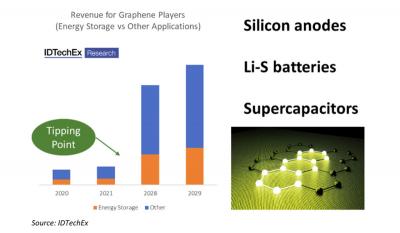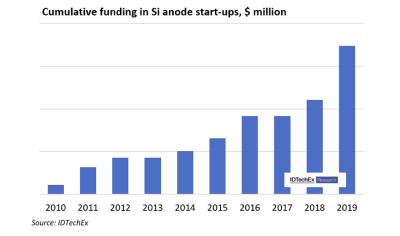This is a sponsored post by Dr. Alex Holland, IDTechEx
Graphene has been heralded as a wonder material for years, with many believing a tipping point is rapidly approaching. It undoubtedly has the potential for use in numerous applications with one of the most notable being the energy storage market. Li-ion demand for plug-in electric cars alone is forecast to be nearly 350 GWh by 2025. IDTechEx forecasts that over 30% of the graphene market will be used in energy storage applications within the next decade with multiple high-profile use cases; see IDTechEx’s reports Li-ion Batteries 2020-2030, and Graphene, 2D Materials and Carbon Nanotubes 2019-2029 for more details.

One of the most significant technological developments in energy storage regards the use of silicon dominant anodes in Li-ion batteries. The theoretical capacity of silicon is around 10x that of graphite and has therefore been the topic of intense activity in the Li-ion market - Over $500 million has been invested in silicon anode start-ups alone since 2015. However, the material is plagued by one major issue: when lithiated, it can expand in volume by 300%. This causes various issues around loss of electrical connection between electrode particles and decomposition of the electrolyte, which ultimately leads to poor cycle life.
Graphene can provide a solution to these problems. For example, Nanograf wrap silicon material in graphene, which can accommodate for this expansion and protect against electrolyte decomposition. It can also be used to provide a conductive network to help maintain electrical conductivity despite the repeated expansion/contraction of silicon. Graphene also has potential at the cathode, where it can improve the conductivity and capacity retention of different cathode materials. Numerous graphene players are showcasing the potential for their material in the industry with some very promising results. However, it would be foolish to overlook other routes already further along in this field. For more information on all the underlying technology progressions, player analysis, and market outlook, see: Li-ion Batteries 2020-2030.

Beyond lithium-ion technology, graphene can enhance the performance of next generation lithium-sulphur batteries. The battery promises lower costs due to the use of widely available sulphur as the cathode. Combined with a lithium metal anode and improvements to specific energy (Wh/kg) have also been achieved. Unfortunately, there are similarities between silicon and sulphur in that sulphur is also prone to stability issues polysulphides tend to dissolve and diffuse to the anode where they react and cause a loss of active material. Furthermore, sulphur is not conductive and also expands during lithiation, though not to the extremes of silicon, and so requires both conductive additives and space within the electrode for the sulphur to expand into. Norwegian start-up Graphene Batteries employ a graphene network which provides a conductive network, space for volume expansion and may also help to trap polysulphides from diffusing to the anode. Nevertheless, the lithium-sulphur chemistry is still at the very early stages of commercialisation with various performance parameters needing to be improved upon and demonstrated.
The highly specific surface area and conductivity of graphene meant its first application in energy storage, that gained traction, was not in batteries but supercapacitors (capacitance is directly proportional to surface area). The theoretical specific capacitance of a single graphene layer is 550 F/g, 3-4 times the capacitance achieved from activated carbon in organic electrolyte (the incumbent electrode material). Companies are exploring μF chips through to kF modules for IoT devices through to wind turbines and off-road vehicles. All are looking at different ways to cost-effectively incorporate graphene without re-stacking or by appropriately modifying the surface. Unfortunately, the use of graphene has so far resulted in minimal improvements to specific capacitance or energy density. Graphene has been able to further improve power density but given power and fast charge/discharge capability are already strengths of supercapacitors, it is unlikely to unlock significant new markets.
Graphene can help enable lithium-sulphur technology and improve supercapacitor performance but IDTechEx believe they are most likely to occupy niche positions in the energy storage market, see Advanced Li-ion & Beyond Li-ion Batteries 2018-2028. Li-ion technology is set to dominate over the coming decade and here, graphene can play an important role. Analysts at UK-based market research company, IDTechEx, cover various aspects of the energy storage and graphene markets, assessing the trends, bottlenecks and market potential of new materials and technologies. The newly updated report Li-ion Batteries 2020-2030 provides a comprehensive view of the Li-ion market and the opportunities for new materials, while the report Graphene, 2D Materials and Carbon Nanotubes 2019-2029 provides detailed analysis of the titled materials, their commercial progress and their prospects moving forward. For the full portfolio of energy research available from IDTechEx please visit www.IDTechEx.com/research/ES.
IDTechEx guides your strategic business decisions through its Research, Consultancy and Event products, helping you profit from emerging technologies. For more information on IDTechEx Research and Consultancy contact research@IDTechEx.com or visit www.IDTechEx.com.

